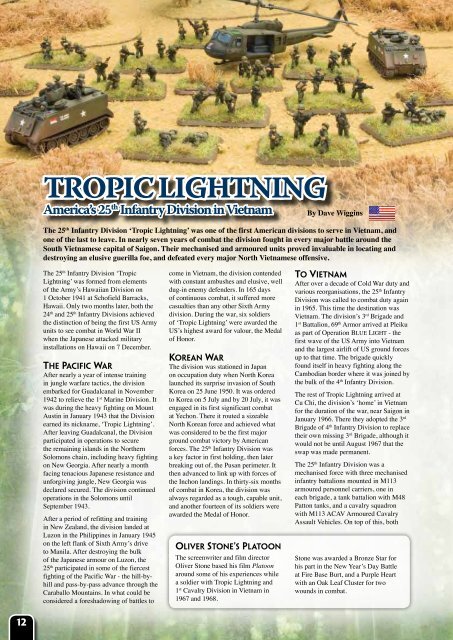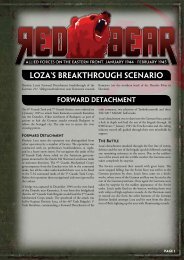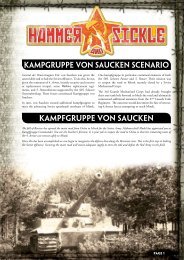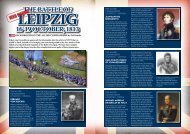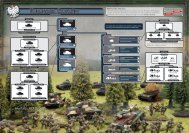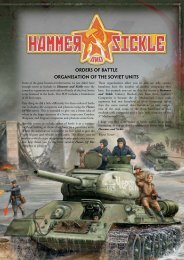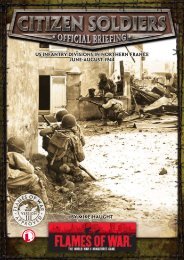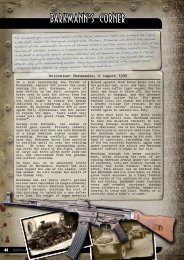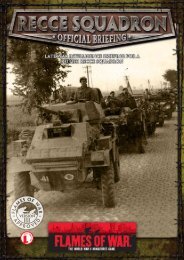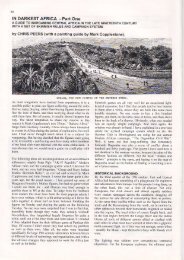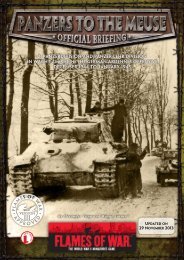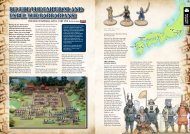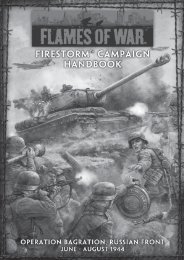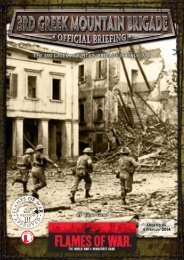You also want an ePaper? Increase the reach of your titles
YUMPU automatically turns print PDFs into web optimized ePapers that Google loves.
<strong>Tropic</strong> LightningAmerica’s 25 th Infantry Division in VietnamBy Dave WigginsThe 25 th Infantry Division ‘<strong>Tropic</strong> Lightning’ was one <strong>of</strong> the first American divisions to serve in Vietnam, andone <strong>of</strong> the last to leave. In nearly seven years <strong>of</strong> combat the division fought in every major battle around theSouth Vietnamese capital <strong>of</strong> Saigon. Their mechanised and armoured units proved invaluable in locating anddestroying an elusive guerilla foe, and defeated every major North Vietnamese <strong>of</strong>fensive.The 25 th Infantry Division ‘<strong>Tropic</strong>Lightning’ was formed from elements<strong>of</strong> the Army’s Hawaiian Division on1 October 1941 at Sch<strong>of</strong>ield Barracks,Hawaii. Only two months later, both the24 th and 25 th Infantry Divisions achievedthe distinction <strong>of</strong> being the first US Armyunits to see combat in World <strong>War</strong> IIwhen the Japanese attacked militaryinstallations on Hawaii on 7 December.The Pacific <strong>War</strong>After nearly a year <strong>of</strong> intense trainingin jungle warfare tactics, the divisionembarked for Guadalcanal in November1942 to relieve the 1 st Marine Division. Itwas during the heavy fighting on MountAustin in January 1943 that the Divisionearned its nickname, ‘<strong>Tropic</strong> Lightning’.After leaving Guadalcanal, the Divisionparticipated in operations to securethe remaining islands in the NorthernSolomons chain, including heavy fightingon New Georgia. After nearly a monthfacing tenacious Japanese resistance andunforgiving jungle, New Georgia wasdeclared secured. The division continuedoperations in the Solomons untilSeptember 1943.After a period <strong>of</strong> refitting and trainingin New Zealand, the division landed atLuzon in the Philippines in January 1945on the left flank <strong>of</strong> Sixth Army’s driveto Manila. After destroying the bulk<strong>of</strong> the Japanese armour on Luzon, the25 th participated in some <strong>of</strong> the fiercestfighting <strong>of</strong> the Pacific <strong>War</strong> - the hill-byhilland pass-by-pass advance through theCaraballo Mountains. In what could beconsidered a foreshadowing <strong>of</strong> battles tocome in Vietnam, the division contendedwith constant ambushes and elusive, welldug-in enemy defenders. In 165 days<strong>of</strong> continuous combat, it suffered morecasualties than any other Sixth Armydivision. During the war, six soldiers<strong>of</strong> ‘<strong>Tropic</strong> Lightning’ were awarded theUS’s highest award for valour, the Medal<strong>of</strong> Honor.Korean <strong>War</strong>The division was stationed in Japanon occupation duty when North Korealaunched its surprise invasion <strong>of</strong> SouthKorea on 25 June 1950. It was orderedto Korea on 5 July and by 20 July, it wasengaged in its first significant combatat Yechon. There it routed a sizeableNorth Korean force and achieved whatwas considered to be the first majorground combat victory by Americanforces. The 25 th Infantry Division wasa key factor in first holding, then laterbreaking out <strong>of</strong>, the Pusan perimeter. Itthen advanced to link up with forces <strong>of</strong>the Inchon landings. In thirty-six months<strong>of</strong> combat in Korea, the division wasalways regarded as a tough, capable unit,and another fourteen <strong>of</strong> its soldiers wereawarded the Medal <strong>of</strong> Honor.Oliver Stone’s PlatoonThe screenwriter and film directorOliver Stone based his film Platoonaround some <strong>of</strong> his experiences whilea soldier with <strong>Tropic</strong> Lightning and1 st Cavalry Division in Vietnam in1967 and 1968.To VietnamAfter over a decade <strong>of</strong> Cold <strong>War</strong> duty andvarious reorganisations, the 25 th InfantryDivision was called to combat duty againin 1965. This time the destination wasVietnam. The division’s 3 rd Brigade and1 st Battalion, 69 th Armor arrived at Pleikuas part <strong>of</strong> Operation Blue Light - thefirst wave <strong>of</strong> the US Army into Vietnamand the largest airlift <strong>of</strong> US ground forcesup to that time. The brigade quicklyfound itself in heavy fighting along theCambodian border where it was joined bythe bulk <strong>of</strong> the 4 th Infantry Division.The rest <strong>of</strong> <strong>Tropic</strong> Lightning arrived atCu Chi, the division’s ‘home’ in Vietnamfor the duration <strong>of</strong> the war, near Saigon inJanuary 1966. There they adopted the 3 rdBrigade <strong>of</strong> 4 th Infantry Division to replacetheir own missing 3 rd Brigade, although itwould not be until August 1967 that theswap was made permanent.The 25 th Infantry Division was amechanised force with three mechanisedinfantry battalions mounted in M113armoured personnel carriers, one ineach brigade, a tank battalion with M48Patton tanks, and a cavalry squadronwith M113 ACAV Armoured CavalryAssault Vehicles. On top <strong>of</strong> this, bothStone was awarded a Bronze Star forhis part in the New Year’s Day Battleat Fire Base Burt, and a Purple Heartwith an Oak Leaf Cluster for twowounds in combat.12
North/South Border (DMZ)TROPIC LIGHTNINGIN VIETNAM1965 - 1971Khe SanhHue• Da Nang•Chu Lai• Dak To• Duk PhoPleikuMang YangPass•An Khe• Qui NhonIa DrangSnuolCam Ranh Bay•Fish HookBATTLEs INsOuTH VIETNAM1 st Cavalry Division(Airmobile) ‘The First Team’Prey VengBen CuiTay NinhParrot’s BeakCu ChiIron Triangle•SaigonBien Hoa4 th Infantry Division ‘Ivy’25 th Infantry Division‘<strong>Tropic</strong> Lightning’11 th Armoured CavalryRegiment ‘Black Horse’Mekong DeltaB2 Front0 KM 500 Miles10050 10013
25TH InfANTRy DIVIsION ‘TROPIC LIGHTNING’1 st Brigade 2 nd Brigade 3 rd Brigade4 th Bn, 9 th Infantry(Manchu)Keep Up the Fire2 nd Bn, 14 th Infantry(Golden Dragons)The Right <strong>of</strong> the Line4 th Bn (Mech), 23 rd Infantry(Tomahawks)We Serve7 th Bn, 11 th Artillery(The Dragon Regiment)On Time3 rd Squadron, 4 th Cavalry(Fourth Cav)Paratus et Fideles(Prepared and Loyal)25 th Aviation Battalion(A Tp - Little Bear)(B Tp - Diamond Head)Lele Makou No Na Puali(We Fly For The Troops)1 st Bn (Mech), 5 th Infantry(Bobcats)I’ll Try, Sir1 st Bn, 27 th Infantry(The Wolfhounds)Nec Aspera Terrent(No Fear on Earth)2 nd Bn, 27 th Infantry(The Wolfhounds)Nec Aspera Terrent(No Fear on Earth)2 nd Bn, 8 th Artillery(Automatic Eighth)Audacieux et Tenace(Daring and Tenacious)Divisional Troops3 rd Bn (155mm/8in),13 th Artillery(The Clan)Without Fear, Favor,or Hope <strong>of</strong> Reward(from 4 th Division)2 nd Bn, 12 th Infantry(<strong>War</strong>riors)Ducti Amore Patriae(Led by Love <strong>of</strong> Country)2 nd Bn (Mech) 22 nd Infantry‘Triple Deuces’(The Regulars)Deeds Not Words3 rd Bn, 22 nd Infantry(The Regulars)Deeds Not Words2 nd Bn, 77 th ArtilleryEn Garde(On Guard)2 nd Bn, 34 th Armor‘Dreadnaughts’(Centurions)The Strong Arm for Victory1 st and 3 rd Squadrons11 th Armored Cavalry(Black Horse)Allons, (Let’s Go)(Temporarily Attached)2 nd Bn, 27 th Infantry Battalion and regiment numbers: Regiments did not fight as units. Individual battalions were assigned to brigades.(The Wolfhounds) Regimental nickname: Commonly used within division. Some battalions and companies had their own nicknames.Nec Aspera Terrent Regimental motto: Where the motto is in Latin, it is translated in brackets afterwards.(No Fear on Earth)the 1 st and 3 rd Squadrons <strong>of</strong> the famous11 th Armored Cavalry Regiment(‘Blackhorse’) were also attached tothe division for some operations.The Iron TriangleThe division’s missions consisted <strong>of</strong>fighting in terrain that was hardly suitedto conventional mechanised operations,and <strong>Tropic</strong> Lightning, and the Army as awhole, had to adapt both equipment andtactics to this environment. Dr RonaldGlasser who treated the division’swounded describes the 25 th InfantryDivision’s assigned area, the well-known‘Iron Triangle’, and its role:The headquarters for the 25 thDivision lay forty miles northwest <strong>of</strong>Saigon, in the foothills <strong>of</strong> the centralhighlands. The Army had placed itastride one <strong>of</strong> the major infiltrationroutes from Cambodia; part <strong>of</strong> theprotective arc <strong>of</strong>fered up to Saigonby the 9 th Division in the Delta,the 25 th , based on Cu Chi, and theAmerical and the 1 st Division farthernorth. During the dry season, theland the 25 th worked reached fromimpenetrable jungle, triple canopied,in the west to rice paddies in the southand north. During the monsoons, thejungle became wet and the paddiesimpassable, but it was dry now;the jungle was burning <strong>of</strong>f and thepaddies were rock-hard.After arriving at Cu Chi, the Division hadto contend with the vast and still activetunnel complex <strong>of</strong> Cu Chi, literally inits own back yard. The tunnels had beentargeted by US and Australian forcesduring Operation CRIMP in 1966, anddespite much <strong>of</strong> the complex beingdestroyed, the tunnels had remainedan active and important resource forthe enemy. The tunnel complexes inthe Iron Triangle proved especiallychallenging to the division’s mechanisedunits. As one soldier put it:They’ve had twenty years <strong>of</strong> makingtunnels-all over the area-all overNam, I guess. Sometimes they godown deep; sometimes they’re nearthe surface. When they get near thesurface like this one, they run themparallel to where they think we mightbe going. All you have to do is puncha hole out <strong>of</strong> the side, lie there withyour RPG, and when a track comes byor a squad, BAMB!Despite the challenges posed by jungle,rugged terrain, paddies, and monsoonsthat turned dirt roads into muddyquagmires, the mechanised, armour, andcavalry forces played a vital role in USstrategy throughout the war. Along withthe UH-1 helicopter, the M113 armouredpersonnel carrier became an iconic image<strong>of</strong> the Vietnam <strong>War</strong>.Operations in VietnamFrom 1966 to 1970, the Division’s mainarea <strong>of</strong> operations was the area north14
Hanoi’s Saigon FrontVietnamese Forces in the Battle for SaigonBy Dave WigginsThe People’s Army <strong>of</strong> Vietnam viewed the area around Saigon as critical to winning the Vietnam <strong>War</strong>. TheirB2 Front commanded the North Vietnamese forces in and around Saigon and the Mekong Delta. The battlesthere were tough and hard fought. Both sides made major <strong>of</strong>fensives like the American Operation Cedar Fallsand the North Vietnamese Tet <strong>of</strong>fensive, but neither side was able to decisively beat the other in combat. In theend it was the North Vietnamese willingness to take casualties and keep fighting that won the war for them afterthe United States finally withdrew from Vietnam after seven long years.The North Vietnamese headquarters forthe southern half <strong>of</strong> South Vietnam wasknown to the US forces as COSVN—Central Office for South Vietnam. Itsarea <strong>of</strong> responsibility covered one-half <strong>of</strong>the land and two-thirds <strong>of</strong> the population<strong>of</strong> South Vietnam. Operating underCOSVN was the B2 Front, the militarycommand for the area (B1, B3 and B4Fronts operated in the northern half <strong>of</strong>the country). It is no accident, then, thatthe area where B2 Front operated wasconsidered ‘the Bulwark Theatre’ by theNorth Vietnamese. The importance <strong>of</strong>COSVN to the North Vietnamese wareffort was appreciated by the Americans,and it remained a high priority target forthe duration <strong>of</strong> the war.The headquarters <strong>of</strong> this massivearea, was at one point located in thehuge Memot rubber plantation in the‘Fish Hook’ in Cambodia, north <strong>of</strong> the25 th Infantry Division’s headquarters atCu Chi. The extensive tunnel complexcreated at Cu Chi was designed to be anessential control and logistical element inCOSVN’s conduct <strong>of</strong> military operations.The Forces <strong>of</strong> B2 FrontDuring the first stages <strong>of</strong> the war, theforces in the south were largely fromthe People’s Liberation Armed Forces(PLAF) <strong>of</strong> the National LiberationFront (NLF). These were known to theSouth Vietnamese as VC or Việt Cộng,a contraction <strong>of</strong> Việt Nam Cộng-sản(Vietnamese communist). Americansoldiers referred to communist forcesin general, both Vietcong and NorthVietnamese, as Viet Cong.In 1965 B2 grouped its forces,supplemented by a big influx <strong>of</strong>regular army regiments from the NorthVietnamese People’s Army <strong>of</strong> Vietnam(PAVN), into three divisions: 5 th , 7 th ,and 9 th . These divisions were <strong>of</strong>ficially‘Main Force’ PLAF divisions, disguisingthe presence <strong>of</strong> the PAVN regulars. TheMain Force divisions were composed <strong>of</strong>three regiments, and each regiment hada designated combat speciality: mobileoperations, attacking fortifications, orambush operations, but were able t<strong>of</strong>ight in any situation that might presentitself. In addition to the three Main Forcedivisions, B2 Front also commandedup to three sapper battalions (assaultcommandos), two rocket artilleryregiments, and an air defence battalion,and ‘Local Force’ guerillas operating atthe district and village level.16
B2 Front in South VietnamIt can be very hard to find information on PAVN units, so I have summarised the main force divisions fighting under B2 Front. In late 1969, the Frontalso commanded three (4 th , 7 th , and 8 th ) sapper battalions, several independent regiments, two rocket regiments, and an anti-aircraft battalion. By thisstage the VC contribution had massively declined after three years <strong>of</strong> fighting the American forces and the losses in the Tet <strong>of</strong>fensive. The main sourcewas Chiangshan’s posts on http:www.armchairgeneral.com/forums/showthread.php?t=82511.Sư Đoàn 5 (5 th Division)Formed Sep 1965. Operated in theMekong Delta. Rebuilt with PAVNregiments after Tet <strong>of</strong>fensive. Theseregiments had been formed for the FirstIndochina <strong>War</strong> against the French.Trung Đoàn 4 (4 th Regiment) until Apr 1968Name: ‘Đồng Nai’ (Name <strong>of</strong> province)Trung Đoàn 33 (33 rd Regiment) from Jul 1968Formed from 101B and 101C, 325 th DivisionName: ‘Trần Cao Vân’ (Anti-French leader)Trung Đoàn 5 (5 th Regiment) until Jun 1970Known to US as 275 th RegimentTrung Đoàn 3 (3 rd Regiment) from Jul 1970Formed from 1 st Battalion, 5 th RegimentTrung Đoàn 88 (88 th Regiment) from Sep 1967to Sep 1968. Previously 88A, 308 th DivisionName: ‘Tu Vũ’ (Name <strong>of</strong> village)Trung Đoàn 174 (174 th Regiment) from Oct 1968Previously 174A Regiment, 316 th DivisionName: ‘Cao Bắc Lạng’ (1949 campaign)Sư Đoàn 7 (7 th Division)Formed Jun 1966. Operated south <strong>of</strong>the Mekong Delta. Created from 312 th‘Victory’ Division which then rebuilt itsregiments as 141B and 165B.Trung Đoàn 12 (12 th Regiment)Previously 165A Regiment, 312 th DivisionName: ‘Lao Hà Yên’ (Name <strong>of</strong> province)Trung Đoàn 14 (14 th Regiment)Previously 141A Regiment, 312 th DivisionName: ‘Ba Vì’ (Mountain range)Trung Đoàn 16 (16 th Regiment) until late 1967Previously 101A Regiment, 325A DivisionName: ‘Trần Cao Vân’ (Anti-French leader)Trung Đoàn 52 (52 nd Regiment) Sep to Nov 1967Previously with 320A DivisionName: ‘Tây Tiến’ (Western Progress)Trung Đoàn 209 (209 th Regiment) from Jan 1968Previously 209A Regiment, 312 th DivisionName: ‘Sông Lô’ (Lô River)Sư Đoàn 9 (9 th Division)Formed Sep 1965. Operated in theIron Triangle. First division formed inthe south. Created from independentregiments. Suffered heavy casualties inOperation Junction City.Trung Đoàn 1 (1 st Regiment)Previously 812 th Regiment, then 271ARegiment or Q761 <strong>of</strong> B2 FrontName: ‘Bình Giã’ (Name <strong>of</strong> village)Trung Đoàn 2 (2 nd Regiment)Previously 272A Regiment or Q762 <strong>of</strong> B2 FrontName: ‘Đồng Xoài’ (Name <strong>of</strong> town)Trung Đoàn 3 (3 rd Regiment) until Sep 1968Previously 3 rd or 273 rd Regiment <strong>of</strong> B2 FrontTrung Đoàn 3B (3B Regiment) from Oct 1968to Sep 1969. Previously 88 th , 5 th DivisionName: ‘Tu Vũ’ (Name <strong>of</strong> village)Trung Đoàn 3 (3 rd Regiment) from Oct 1969Previously 95C Regiment, 325C DivisionName: ‘Nguyễn Thiện Thuật’ (Revolutionary)PAVN divisions and regiments had a confusing variety <strong>of</strong> names. In part this was caused by the need to send reinforcements south to rebuild destroyedregiments. Regiments could be rebuilt with the letter B (or C or even D in some cases) after their number, or simply replaced with another regiment.As a result 33/7, 101/7, 101B/325, and 101C/325 all refer to the same regiment, which might also be referred to as 4/7 after the regiment it replaced.The Vietnamese also deliberately caused confusion by referring to units by different names, such as Công Trường 9 (Construction Site 9), a codenamefor the 9 th Division.The North Vietnamese were adept atconcealing their true order <strong>of</strong> battleand the level <strong>of</strong> casualties they weresustaining. A continuous stream <strong>of</strong>replacement soldiers from North Vietnamfollowed the Ho Chi Minh trail souththrough Laos and Cambodia to replaceon-going casualties. In the aftermath <strong>of</strong>major battles, whole PAVN regimentswould be sent south to replace thoselost in battle. These were replaced inthe PAVN’s order <strong>of</strong> battle with newregiments with the same number, but witha B suffix, and on arrival in the southwere renamed to replace the destroyedregiment. As you can imagine, this ledto considerable confusion in Americanintelligence estimates which identified308 th , 312 th , 320 th and 325 th PAVNDivisions as operating in the area.COSVN’s StrategyThe forces <strong>of</strong> B2 Front showedthemselves to be fully capable <strong>of</strong>defeating the South Vietnamese Army<strong>of</strong> the Republic <strong>of</strong> Vietnam (ARVN)on the battlefield more <strong>of</strong>ten than not.Indeed, B2 Front’s dry season campaign<strong>of</strong> 1964 had as one primary objectivethe engagement and defeat <strong>of</strong> the mostcapable ARVN units, leading to thelarge-scale intervention <strong>of</strong> the UnitedStates in 1965. Early defeats againstthe much better equipped and led USArmy forced B2 Front’s leadership tore-evaluate their strategy.General Tran Van Tra, commandingB2 Front, and his planners recognizedthat they could not expect to decisivelydefeat the US forces in Vietnam. The USforces were more mobile, and could bringsuperior firepower to bear in almost anysituation. Also, since the US controlledthe skies <strong>of</strong> South Vietnam, resupply<strong>of</strong> B2 Front forces so as to maintaintheir combat effectiveness would be aconsiderable challenge. Thus, strategyshifted. Rather than fighting large battlesto defeat US forces, B2 Front began along war <strong>of</strong> attrition designed to inflictcontinuous casualties and ultimatelydemoralize the US forces.Despite appearances, the 1968 Tet<strong>of</strong>fensive was not a departure fromthis strategy. While it was a large-scale<strong>of</strong>fensive, both in numbers <strong>of</strong> troopsand the area covered, they still avoidedlarge battles whenever possible. Thetargets were individual towns, populationcentres, communications centres, andother important infrastructure. The speedand violence <strong>of</strong> the US Army’s responsecaught the Vietnamese <strong>of</strong>f guard, leadingto massive casualties, and ultimatelyanother large influx <strong>of</strong> North Vietnameseregular regiments. Despite this setback,B2 Front’s strategy to end Americaninvolvement in Vietnam by making theAmericans tired <strong>of</strong> the war and forcingthem to leave Vietnam continued.With the American departure in 1971,large-scale battles against the ARVNresumed, now supported by artilleryregiments and even tanks. With thesebattles B2 Front was instrumentalin bringing about the ultimatecollapse <strong>of</strong> ARVN forces and thefall <strong>of</strong> South Vietnam.17
Other missions in VietnamUsing the Standard <strong>Flames</strong> Of <strong>War</strong> Missions for Vietnam GamesBy Phil YatesWhile the <strong>Tropic</strong> Lightning booklet has four new Vietnam-specific missions, you can still play all the standard<strong>Flames</strong> Of <strong>War</strong> missions from the rulebook and the website (www.<strong>Flames</strong>Of<strong>War</strong>.com). These will play verydifferently in Vietnam due to the US Army’s helicopters and the PAVN’s guerilla tactics.The two standard fair fight missionsare Free-For-All and Encounter. Theseare normally straight-forward headto-headbattles, the only differencebetween them being that the players havereserves coming in from turn three inEncounter. When playing in Vietnam, theVietnamese special rules make them intovery different missions.Thanks to the ‘Guerilla Reserves’ inOther Missions rule (on page 35 <strong>of</strong> the<strong>Tropic</strong> Lightning booklet), the Vietnamesestart with only one platoon (Vietnamesecompany) on the table, but when theirreserves start appearing, they are likely toappear behind enemy forces threateningthe objective - ready to either attack themfrom behind or attack objectives leftvulnerable by the enemy advance.Combined with the Vietnamese ‘Bornin the North to Die in the South’special rule that allows them to putdestroyed companies back in reserve,the battle loses its linear character,forcing the US player to be ready toblock continuous surprise attacks andmaintain secure flanks while advancing.Counterbalancing this, US airmobileforces are excellent in this sort <strong>of</strong> missionas they can land infantry right beside theobjective on the other side <strong>of</strong> the tableearly in the game.The defensive battle missions also playvery differently. The ‘Charlie Ownsthe Night’ special rule means that if theNorth Vietnamese do end up attacking, itwill be at night. If they are defending, theattacking American forces will be subjectto a continuous series <strong>of</strong> ambushes thanksto the ‘Guerilla Reserves’ special rule.The Us player’s big advantage at the start<strong>of</strong> the battle is that they’ll only be facinga single Vietnamese company. Theyneed to take advantage <strong>of</strong> this and attackhard, trying to win the game before theVietnamese ambushes bog them downand whittle away their combat power.When defending in Hold the Line or NoRetreat, the Vietnamese player startsweak, relying on their determination t<strong>of</strong>ight to the death and massed B-40 andB-41 rocket-propelled grenades to keepthe Americans at bay until their guerillareserves start hitting the US forces inthe flank. Once that starts happening,the American player will be strugglingagainst a steadily mounting casualty listas they try to clear a path to the objectivewith their massed firepower.Fighting Withdrawal changesdramatically in Vietnam. With theVietnamese attacking, it makes agreat game where the US forces areattempting to break contact underfire. The battle starts at night and theattacking companies spring up fromall over the battlefield, forcing the USplayer to maintain an all-round defensiveposture as their force slowly evacuates.If the Vietnamese are defending, theVietnamese forces actually grow duringthe first part <strong>of</strong> the battle as they race tothe battlefield to give their headquarterstime to remove crucial papers andsupplies from an underground tunnelcomplex before abandoning the position.Even once you’ve played all <strong>of</strong> thebooklet and standard missions, thereare still plenty <strong>of</strong> new challenges. Getaccounts <strong>of</strong> actual battles and modifythe missions to create your ownscenarios. The <strong>Tropic</strong> Lightning News(www.25thida.org/TLN) and other unitwebsites are terrific sources for this, as isthe US Army’s Center <strong>of</strong> Military History(www.history.army.mil).So, what’re you waiting for soldier?Saddle up ’n’ move out!40
CONTACT!By Kyran Henryand Mark HazellCONTACT!A Search and Destroy Mission in VietnamWhen we heard about the battle report to go with the <strong>Tropic</strong> Lightningbooklet, both Mark and I jumped at the chance to play. We are both keenlyinterested in the Vietnam <strong>War</strong> (my father served in 7 RAR with the Australian Army),and the game looked like it would be a serious challenge for both sides. Mark was keen to try outthe armoured cavalry and Hueycobra gunships, so I put together a North Vietnamese force and we set to.The mission we were to play is theContact! Contact! mission from the<strong>Tropic</strong> Lightning booklet. It starts withan American force being ambushed enroute to rescuing the crew <strong>of</strong> a crashedhelicopter and investigating a suspectedNorth Vietnamese arms cache. Onlyhalf <strong>of</strong> the American force is initiallyavailable, but the ambush is only a singleVietnamese company. The openingmoves will be tense as the two forcesclash. Both sides will be reinforced asmore troops are drawn into the growinglife-or-death struggle.If the Americans can reach and hold thehelicopter on or after turn six, they’llwin. On the other hand, if the Vietnamesecan break the American force before thathappens, or simply amass a good enoughexchange ratio, they’ll win.The battle is taking place towards the end<strong>of</strong> the dry season in 1969, so aside frompatches <strong>of</strong> woods, the majority <strong>of</strong> thebattlefield is covered in ‘elephant grass’.We scattered patches <strong>of</strong> tall grass about toshow this, but the whole area not coveredby the road, buildings or woods wasassumed to be the same tall grass.We rolled to see just how tall the elephantgrass is in this area and found out that itis head high. This means that everyonecan see and be seen by vehicles (althougheveryone is concealed), but limitsvisibility to 6''/15cm between troops onthe ground. While it will make it muchharder to pin my troops down withAmerican firepower, it should help Marksurvive the ambuscade.MARK’S PLANMy plan is simple - get to the chopper!Knowing that I’m going to get ambushed,I’ve spread out my M113 ACAV’s tokeep the ambush as far from the core<strong>of</strong> my force as possible. The Cobras areflying close support overhead, so I shouldbe able to respond to the ambush withsome serious firepower. Meanwhile, theairmobile platoon is on its way to pounceon the objective and my flame-throwerplatoon should arrive just in time forsome serious action.KYRAN’S PLANIn the test games, the scariest thing wasthe sheer number <strong>of</strong> machine-guns thatthe Americans have, so the first priority iskilling some <strong>of</strong> the M113 ACAV’s. As theambuscade lets me get nice and close andhit the Pattons in the flanks, it is worthputting some RPG’s into them as well.After that, the plan is simple. KillAmericans as fast as possiblewhile losing as few <strong>of</strong> my own unitsas possible.28BattleReport.indd 5 11/2/11 13:50:30
HQH2US FORCESTroop HQ M Mortar Platoon Battalion HQ Sapper CompanyArmored Cavalry PlatoonHQ SectionTank SectionScoutSection 1Flame-throwerPlatoonTank PlatoonB-411 B-40ScoutSection 2Rifle Platoon(Airmobile)Aviation Platoon(Airmobile)AeroweaponsPlatoonVIETNAMESE FORCESHMG NestType 52 75mmrecoilless gunsInfantry Companywith B-41Infantry Companywith B-40Anti-air PlatoonDivisional RecoillessGun CompanyDivisional MortarCompanyDivisional Anti-airPlatoonvietnam1963-1973US MovementVietnamese MovementAmbuscadeThe Contact! Contact! mission startswith an ambuscade, completing the‘search’ phase <strong>of</strong> the mission!HQH21B-41LZ OBJECTIVEVietnameseOBJECTIVEThe Vietnamese player places one<strong>of</strong> their companies anywhere on thetable and then opens fire. This ispotentially devastating, and certainlyfreaks out players being ambushed,but never quite seems to do as muchdamage as the players hope or fear.The good news for the Americans isthat casualties taken in the ambuscadedon’t have any effect on the platoon’smorale during the game.Seeing the amount <strong>of</strong> armourthat Mark had placed on the table(thirteen tracks and tanks), Kyrandecided to conduct the ambuscadewith his infantry company equippedwith B-41 anti-tank rockets (thefamous RPG-7) with the 75mmrecoilless guns attached. An inabilityto pass Firepower tests saw the totalcasualties being one M113 ACAVdestroyed and an M48A3 tank,another ACAV and the MG teams’M113 bailed out.29BattleReport.indd 6 11/2/11 13:51:12
US Armored Cavalry TroopFLAME-THROWERPL ATOONAVIATION PL ATOON(AIRMOBILE)TANK PL ATOONMMORTAR PL ATOONRIFLE PL ATOON(AIRMOBILE)HQTROOP HQTiêu Đoàn Bô BinhVietnamese Infantry BattalionB-41INFANTRY COMPANYTYPE 52 75MMRECOILLESS GUNSDIVISIONALRECOILLESS GUN PL ATOONBATTALION HQ30ANTI-AIR PL ATOONHMG NESTSBattleReport.indd 7 11/2/11 13:51:49
Armored Cavalry TroopAEROWEAPONSPL ATOONHHQ SECTION1SCOUT SECTION 1TANK SECTION2SCOUT SECTION 2Armored Cavalry Troop HQ2x M113 ACAV 55 pointsArmored Cavalry PlatoonHQ Section120 points1x M113 ACAV1x M113 track + MG team1x M106 (4.2in) mortar trackTank Section 180 points3x M551 SheridanScout Section 55 points2x M113 ACAVScout Section 60 points1x M113 ACAV1x M113 ACAV with Mk 19 GLMortar Platoon 115 points2x M106 (4.2in) mortar trackFlame-thrower Platoon 55 points2x M132 ZippoTank Platoon365 points2x M48A3 (1 with extra MG)Rifle Platoon (Airmobile) 180 pointsAviation Platoon (Airmobile)3x UH-1D Slick 115 pointsAeroweapons Platoon 260 points1x AH-1G Hueycobrawith twin M200 rocket launchers1x AH-1G Hueycobrawith M195 20mm machine-gunTotal1560 pointsInfantry Battalion HQ 285 points3x HMG Nest3x Type 52 75mm recoilless gunsInfantry Company 440 points2x Infantry Platoonsequipped with B-41Infantry Company 320 points2x Infantry Platoonsequipped with B-40Tiêu Doàn Bô BinhAnti-air Platoon60 points3x Type 54 12.7mm AA MGSapper Company 100 points1x Sapper PlatoonDivisional RecoillessGun Company 100 points3x B10 82mm recoilless gunsDivisional MortarCompany120 points3x Type 53 120mm mortarswith Observer teamDivisional Anti-air Platoon 70 points3x ZPU-1 14.5mm gunswith five crew7x Booby Traps70 pointsTotal1565 pointsB-40INFANTRY COMPANYSAPPER COMPANYDIVISIONALMORTAR PL ATOONDIVISIONALANTI-AIR PL ATOON31BattleReport.indd 8 11/2/11 13:52:07
Turns 1 and 2:Here Comes the Cavalry!HQB-411VietnameseOBJECTIVE62 H2LZ OBJECTIVE14 53Turn 111Massed fire from tanksfiring beehive, ACAVmachine-guns, mortars,and helicopters breaks theambushing company.PAVN player places2five <strong>of</strong> their boobytraps under the leadingUS vehicles. When theymove, they set them <strong>of</strong>f,destroying the dismountedMG team and causing anACAV to bail out.Divisional Anti-air3Platoon arrives fromGuerilla Reserve with itsZPU-1 14.5mm antiaircraftguns and digs incovering the landing zone.Key EventsTurn 245Fire from the onlyACAV in range, thetanks and the mortars allmiss the anti-aircraft guns.Huey Cobras kill twoanti-aircraft guns withchin-mounted minigunsand the 20mm gatling. It’sa good thing for the gunsthat they dug in!Anti-air Platoon with6Type 54 12.7mm AAmachine-guns appearsfrom Guerilla Reserveand completes the trap,shooting down the Cobraarmed with the gatling gun.Mark wishes he’d fired hisrockets last turn!Victory Points1 1Body CountVietnamese:3x B-41 teams4x AK-47 teams2x Type 52 75mm2x ZPU-1 14.5mmUS:1x MG team1x AH-1G Cobra *Units DestroyedVietnamese:Infantry Companywith B-41 **Gains enemy 1 VP2BeehiveFive tanks, including the cavalry’s three M551 Sheridan light tanks, firingbeehive ammunition, half-a-dozen ACAV with three machine-guns each, and twohelicopters shredded the Vietnamese infantry company.A vital round for tanks in Vietnamwas the short-ranged, thoughdevastating, ‘beehive’ canister round,named for the sound <strong>of</strong> more than athousand pellets whizzing past.A tank with beehive ammunition canfire with ROF 5 up to 8''/20cm range.If it moves it adds +1 to the score tohit rather than reducing its ROF.32BattleReport.indd 9 11/2/11 13:53:27
5Fire Support Base1After finishing <strong>of</strong>f the infantry, the AH-1G Hueycobra helicopters turned on theVietnamese anti-aircraft guns, flying straight into a clever ambush!The US Army had an unusualadvantage in Vietnam in that thelimited scope <strong>of</strong> battles meant thatthey could build fortified fire bases tosupport their operations. As a resulttheir artillery rarely took to the field.The Fire Support Base special ruleallows the US player to leave theirartillery <strong>of</strong>f the table and fire underthe control <strong>of</strong> the observer or anyplatoon commander.Mark used his mortar platoon thisway to good effect, even scoring thefinal kill <strong>of</strong> the game with it.43Divisional Anti-air Platoon65The People’s Army <strong>of</strong> Vietnamused a Chinese copy <strong>of</strong> the Soviet12.7mm DShK machine-gun as theirregimental anti-aircraft weapon andthe newer 14.5mm ZPU-1 as theirdivisional weapon. As their heaviestanti-aircraft weapon in the field, theVietnamese needed to get the mostout <strong>of</strong> this relatively light gun.You can model your ZPU-114.5mm anti-aircraft guns with alarger crew <strong>of</strong> five or more figuresto increase their ROF by one,reflecting their importance.33BattleReport.indd 10 11/2/11 13:54:13
Turn 3: The Bô Đôi Strike Back!2Hueycobra WeaponryThe AH-1G Hueycobra was theUS Army’s first custom-designedgunship. Based on the UH-1D Hueyutility helicopter, the Hueycobra wasextensively modified for the gunshiprole. The fuselage was narrowed andthe pilots placed in tandem, givingit the look <strong>of</strong> a fast, sleek killingmachine. The chin turret fitted underthe nose mounted a 7.62mm minigunand a 40mm grenade launcher underthe control <strong>of</strong> the front-seat pilot.This gave the Cobra an effectiveweapon against both infantry in theopen and dug-in troops.The Hueycobra’s main armamentwas carried on its stub wings. Thethree main weapons combinationswere: mixed M157 seven-tube andM200 19-tube rocket launchers, anM195 20mm gatling gun and M157rockets, and the aerial rocket artilleryoption with twin M200 rocketlaunchers. All <strong>of</strong> these are availablein the <strong>Tropic</strong> Lightning booklet.The mixed rocket launcher optionallows the helicopter to fire rocketsevery turn as well as its chin turret.The 20mm gatling gun option givesa lot more direct firepower, but limitsthe rocket pods to a single shot. Themost spectacular though is the twinM200 rocket pod option fitted toMark’s surviving Cobra. This onlyallows a single turn <strong>of</strong> rocket fire,but the 76 rockets cover a massivetarget area. It uses the 12''/30cmsquare Devastating Bombardmenttemplate rather than the usual6''/15cm square artillery template.Despite catching two platoons <strong>of</strong>anti-aircraft weapons under thetemplate, Mark only managed to hitthree teams, and Kyran promptlypassed all <strong>of</strong> his saves!5Despite having nothing left on the table after the Americans first turn <strong>of</strong> shootingwiped out his ambushing company, Kyran took a calculated risk in bringing onanti-aircraft guns rather than more infantry. Kyran placed them guarding thelanding zone that the airmobile infantry would have to use and dug them in,forcing Mark to deal with them. Unable to reach them with ground forces, Marksent in the Cobras, but they were unable to knock out the dug-in guns. ThenKyran sprung his trap, deploying a second platoon <strong>of</strong> anti-aircraft guns, shootingdown both helicopters and gaining three victory points in the process!34BattleReport.indd 11 11/2/11 13:55:59
HQH324B-40LZ OBJECTIVE1VietnameseOBJECTIVE125Victory Points1 3Body CountVietnamese:None!US:2x M551 Sheridan1x AH-1G Cobra *Units DestroyedUS:Aeroweapons Platoon **Gains enemy 1 VPKey EventsWith only the anti-its rocket pods as well as1 4aircraft guns as targets,the lead vehicles open firescoring two machine-gunhits. Kyran saves both!Determined to make2sure this time, theAH-1G Hueycobra firesits minigun. Mark wasstunned when Kyran savedall six hits on rolls <strong>of</strong> 5+.Kyran placed his3remaining booby trapsunder the Troop HQ and anM551 Sheridan tank.Kyran brings theinfantry companywith B-40 rocket launcherson from reserve. Charginginto range, their massedrocket fire destroys theother two M551 Sheridanlight tanks.5Having survivedevery thing, theAnti-air Platoon shootsdown the Cobra, whilethe surviving ZPU-1gun punches holes in theleading ACAV with littlelasting effect.4B40 vs B41Vietnamese players have a choicebetween two rocket launchers, theB40 (Soviet RPG-2) and the B-41(RPG-7). These are quite differentweapons. The B-41 is longer rangedand has much better penetrationagainst tanks, but the B-40 is moreeffective against light armour andunarmoured targets.35BattleReport.indd 12 11/2/11 13:57:01
Turn 4: Tank Killers Run Amok2B-40Mark gets his reserves.1The Zippo flamethrowersdouble up theroad and the slicks carryingthe airmobile infantry landnear the LZ objective.The last remaining2M551 Sheridan sets<strong>of</strong>f the booby trap under it.Obviously a buried aircraftbomb, as the tank blows up!3The ACAV grenadelauncher kills the lastZPU-1 gun and the M113gets a Type 54 12.7mmmachine-gun.The M48A3 tanks4move back, machinegunningthe infantry beforeassaulting. They shouldhave been safe againstB-40’s, but two lucky shotslater, they are both dead!HQ71Key Events14Kyran places his5bunkers to ambushthe landing helicopters, buttheir fire does nothing.Using the ‘Born in the6North to Die in theSouth’ rule, Kyran bringsback the infantry companyequipped with B-41rocket launchers. Theycharge forward killing theM113 track. The ArmoredCavalry Platoon is belowhalf strength, but passes itsPlatoon Morale Check.The B-10 82mm7recoilless guns alsoarrive from reserve, turningup behind the slicks. Theyopen fire, forcing the slickcarrying the rifle platoon’scommand team to return tobase. It will attempt to landagain next turn.2H13B-415 6Victory Points1 7Body CountVietnamese:1x AK-47 team1x Type 54 12.7mm1x ZPU-1 14.5mmUS:1x M551 Sheridan2x M48A3 Patton *1x M113 ACAV1x M113 track1x UH-1D SlickUnits DestroyedUS:Tank Platoon **Gains enemy 1 VPplus 1 VP for fourother tanks and tracksM132 Zippo Flame-throwerEvery tank and mechanised infantrybattalion or cavalry squadron inVietnam had three or four M132‘Zippo’ flame-throwers. These werestandard M113 armoured personnelcarriers fitted with a special flamethrowerturret and four 50 gallon(190 litre) spherical fuel tanks in therear compartment.Like all flame-thrower vehicles,they suffered from short range andlimited fuel supply, but once theygot close to the enemy, their effectwas devastating.42361BattleReport.indd 13 11/2/11 13:57:38
4The M48A3 Patton tank is very well armoured. The pair <strong>of</strong> them should be able toshrug <strong>of</strong>f B-40 hits, but some good shooting sees both <strong>of</strong> them knocked out.6The ‘Born in the North to Die in the South’ rule allowed Kyran to bring a previouslydestroyed infantry company back on as reinforcements.7Born in the Northto Die in the SouthThe Vietnamese tend to takehorrendous casualties when they takeon American firepower in a head-toheadclash. Rather than requiring theVietnamese player to have hundreds<strong>of</strong> stands <strong>of</strong> infantry, we allow themto bring previously destroyed infantrycompanies back on as reserves.We called this rule Born in theNorth to Die in the South to reflect apopular, if rather fatalistic, slogan <strong>of</strong>the North Vietnamese soldiers. Oncesent south few returned to the northbefore the end <strong>of</strong> the war.Mark has both armoured cavalry and airmobile infantry on the objective, but untilturn six, can’t win by holding it. Meanwhile he has to avoid losing!Guerilla Reserves3Lacking in communicationsequipment and forced to disperseto avoid detection, Viet namesecommanders <strong>of</strong>ten found it difficultto mass their troops for a coordinatedresponse to US operations.To reflect this, the Vietnamese playerstarts with just a single company onthe table. As the game progresses,more troops turn up. However, wherethey turn up is somewhat random asthey march to the sound <strong>of</strong> the guns.As the Americans had little ideawhere the Vietnamese guerillas wereuntil they attacked, the Vietnameseplayer places the new arrivals rightup close, ready to fight immediately.637BattleReport.indd 14 11/2/11 13:58:21
Turn 5: Hanging in the Balance21B-40213HQ21 7H1Key EventsThe rifle platoon dismountsfrom the slicks, but without acommander, they can move no further.The commander returns in a new slick.The Zippos move up and2burn every team within reach.Unfortunately for Mark, that’s justtwo B-40 teams.Kyran has six more victory3points than Mark, so unless Markcan get at least one victory point,Kyran will win at the start <strong>of</strong> his turn.Mark’s only hope for victory is todestroy the recoilless gun companyoutright. If successful, he will winsince he holds an objective at the start<strong>of</strong> his sixth turn. No pressure!Despite the cavalry destroying allthree B-10 82mm guns, the commandteam survives, so it’s game to Kyran!Victory PointsBody CountVietnamese:2x B-40 team3x B-10 82mm recoilless gunThe airmobile platoon arrives just in time to prevent the landing zone from beingoverrun. With the platoon commander’s ‘Slick’ unable to land last turn because <strong>of</strong>the recoilless guns’ fire, it returns this turn. Unfortunately, this leaves the troopson the ground leaderless. If the game had gone on another turn, they would havebeen unable to manoeuvre, relying on their firepower to keep assaults at bay.3Having lost his valuable Hueycobra gunships and heavy M48A3 Patton tanks,Mark is way behind on victory points. Unless he can destroy the recoilless guncompany, the General will deem his losses too great for his gains and order him tobreak <strong>of</strong>f the action. Every available M113 swings around to tackle the guns, butdespite taking out all three guns with the help <strong>of</strong> the mortars, the gun commandersurvives, refusing to admit defeat.Victory goes to theVietnamese38BattleReport.indd 15 11/2/11 13:58:59
Body CountArmored CavalryPlatoonHQ SectionTank SectionMARK’S TR ACK OF THE MATCHThat was so close!!!If I had destroyed that gun command team, I would have won! Sure, five victorypoints in the red, but at least it’s a propaganda victory—it would have shownthose Commies they can’t stop the US Army, no matter what the cost.Even though I got to the objective and had killed a pile <strong>of</strong> Kyran’s troops, I failedto score any victory points as I could never quite wipe out a platoon before Kyranmanaged to slink the survivors <strong>of</strong>f the battlefield and out <strong>of</strong> harm’s way.Man <strong>of</strong> the match? That’s a hard choice. It has to be the cavalry’s M113 armouredpersonnel carrier. The armoured cavalry platoon did a magnificent job. Theywere ambushed before the game even began and were still there at the end. M113number 13 was first hit in the ambush. It drove over booby traps that wiped outits rifle team (they should have stayed in the track!), took considerable fire as itmoved to the head <strong>of</strong> the column, and knocked out one anti-aircraft gun beforefinally succumbing to another in Kyran’s last turn.After several games, I’m a thorough convert to armoured cavalry. Their ability totake punishment, then dish out even more in return is unsurpassed.Scout SectionTank PlatoonAviation Platoon(Airmobile)Aeroweapons PlatoonBody CountInfantry Companywith B-41B-41 B-41 B-41Infantry Companywith B-40B-40 B-40KYRAN’S GUNNERS OF THE MATCHA stunning victory! Hooray for RPG’s! If it wasn’t for all my infantry’s B-40and B-41 rocket launchers, I don’t know how I could ever have stopped all thosetanks, but the real heroes were the anti-aircraft gunners. In test games the Cobrashad devastated my infantry every time they tried to attack, and did the same tomy ambushing company this game. This time I decided to do something different.Instead <strong>of</strong> bringing on another infantry company as my reserves, I took a punt andput my anti-aircraft guns around the LZ where the Cobras would have to comeand get them before the Slicks arrived. Mark took the bait, and I sprung the trapnext turn with the second anti-aircraft platoon. Goodbye Cobras!Booby traps-talk about a must have. Mark was too scared to move his troopcommander after the Sheridan blew up! I wasn’t able to take out the ACAV’s thistime, unlike earlier games, but the destruction <strong>of</strong> the Pattons more than made upfor it. Taking out them and the Cobras won the game for me, and I didn’t even usemy whole force. The mortars and sappers were queued up ready to arrive next turn!Guerilla reserves was great. I love the element <strong>of</strong> surprise it brings. This timefortunately, all on Mark’s side, as everyone except my battalion commanderturned up where I needed them.Divisional Anti-airPlatoonAnti-air PlatoonDivisional RecoillessGun CompanyThanksEquipment supplied for photos by theMilitary Re-enactment Society <strong>of</strong> NewZealand. For more information visit:www.ww2reenactors.co.nz39BattleReport.indd 16 11/2/11 13:59:42


